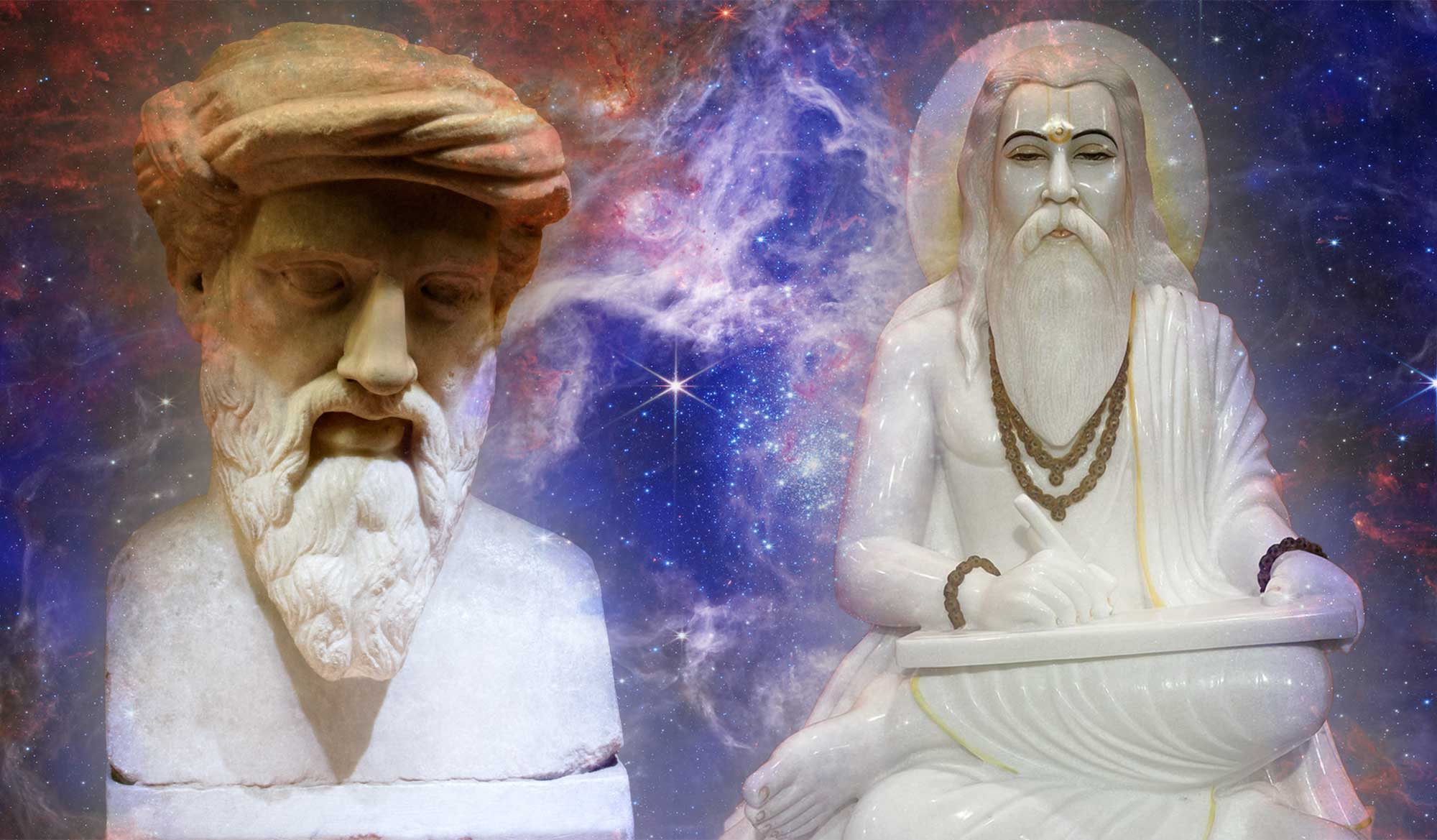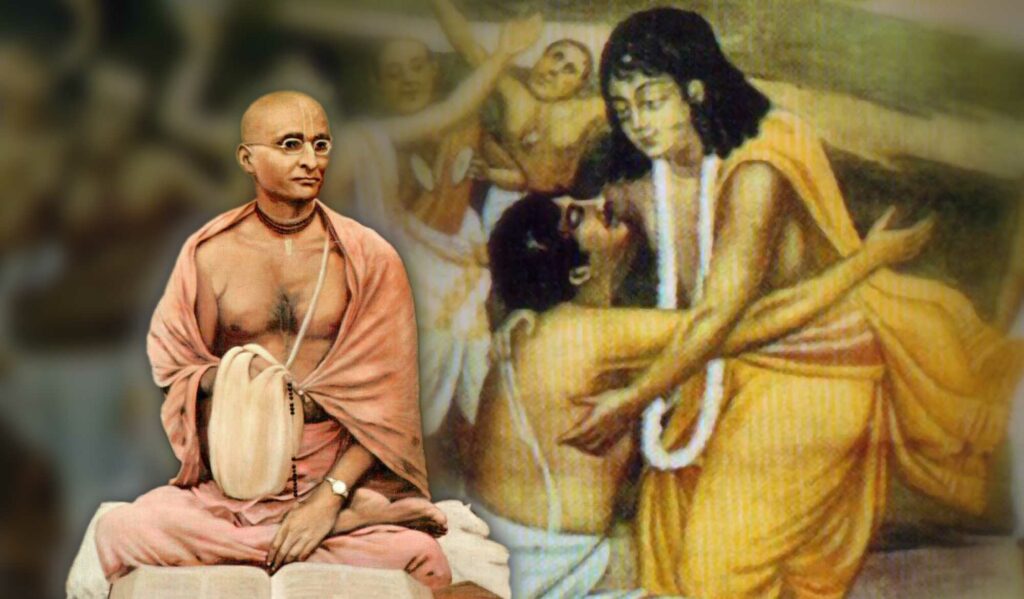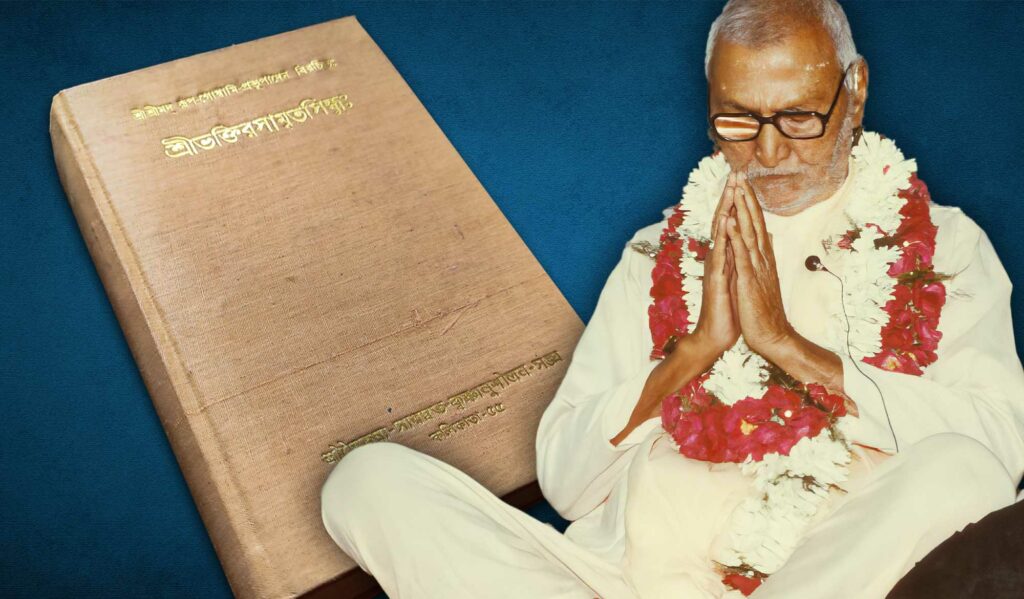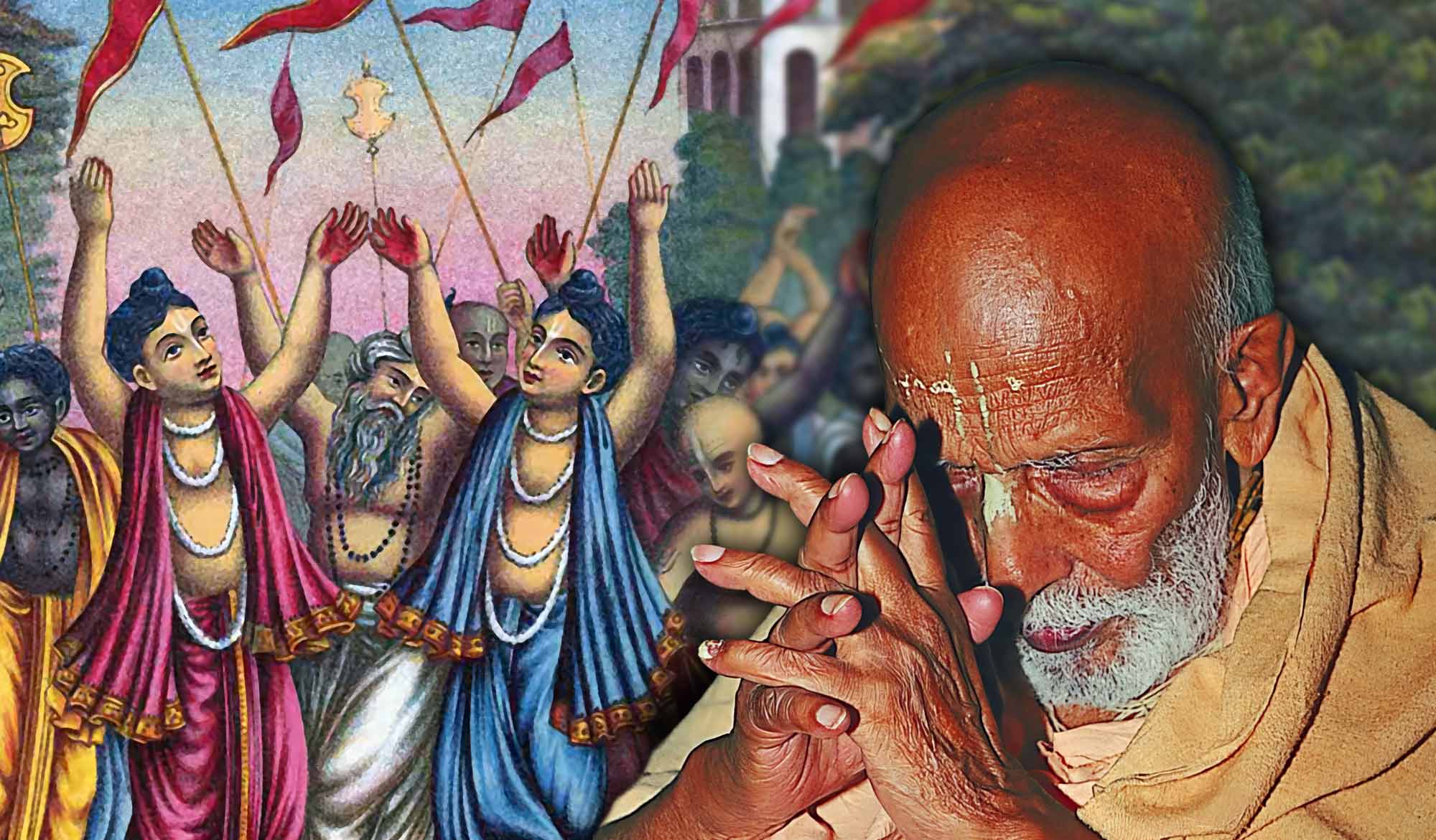Overview
'Rational Vedānta' was written by Swami B.G. Narasingha in October 2006 as an opening statement for a new website he had begun which compared western philosophies with eastern thought. In this article, Narasingha Maharaja explains the meaning of 'Rationalism' and 'Vedānta'. Vedantic and Pythagorean thinking, the stages of realisation according to Vedānta philosophy, and the defects of the so-called Rationalism in today's world.
The term ‘Rational Vedānta’ is derived from the meeting of two schools of thought — East and West: the Vedānta thesis of Vyāsa (3000 BCE in India) and Rational thought of Pythagoras (582–500 BCE in Greece).
Vedānta (which literally means the culmination of knowledge) is part of a greater body of literature known as the Veda. The Vedānta of Vyāsa deals extensively with the philosophical doctrine of Brahman (infinite and finite conscious substance). Higher stages of knowledge in Vedic thought are known as Brahman (infinite and finite conscious substance), Paramātmā (subjective conscious substance) and Bhagavān (super-subjective conscious substance). Below these higher stages of knowledge is the knowledge of cause and effect, time, material manifestation, evolution and so on. The Vedānta is written in Sanskrit and contains 555 sūtras (verses) all of which are extant today and are diligently studied by the followers of Vedic thought, the Vedāntists.
Although reason and logic are useful to explain Vedānta such are not the essential tools to acquire higher knowledge. The body of knowledge in Vedānta is known as śabda–pramāṇa or descending knowledge – independent of mind-intellect speculations. This body of knowledge comes from the satvata-saṁhitā (transcendental plane of knowledge) in the samādhi (trance like meditation) of Vyāsa.
For lack of a proper acquaintance with transcendence some western scholars wish to call the samadhi of Vyāsa ‘a revelation’ as is understood in terms of Christian theology. This understanding however will mislead one to think that the transcendental knowledge of Vyāsa has some similarity to the dogmatism and often lunacy of the commonly referred to world religions. Nothing however could be farther from the truth.
Vedānta being separate from the religious ideas of mundane thinkers one first has to understand the transcendental samadhi of Vyāsa as being on an entirely different platform, the platform of subjective evolution of consciousness.
There are five stages of knowledge in Vedic thought: pratyakṣa, parokṣa, aparokṣa, adhokṣaja and aprākṛta. The first, pratyakṣa, means knowledge acquired by sense experience (experimentation, etc). The second class of knowledge is called parokṣa, or knowledge that is drawn from the experience of other persons, indirect experience. The third stage of knowledge is aparokṣa. Aparokṣa means knowledge by negation – not this, not that, etc. and is commonly thought of as the Buddhist and Śaṅkarite conceptions derived from deep contemplation and reflection. The fourth stage of knowledge is adhokṣaja, subjective or transcendental. That knowledge transcends the mind and intellect. Such knowledge depends upon subjective consciousness. From that level of experience Vyāsa has presented his thesis, Vedānta. After completing Vedānta, Vyāsa went on to compile the commentary on Vedānta known as Śrīmad Bhāgavatam. In Śrīmad Bhāgavatam, Vyāsa presents the super-subjective plane of knowledge, aprākṛta.
Pythagoras (a rationalist and mathematician) pursued the attainment of universal knowledge (along similar lines as Vedānta) thru reason, logic and mathematics. Pythagoras stressed two main teachings: the transmigration of consciousness (the soul) and the theory that numbers constitute the true nature of things. However, none of the direct writings of Pythagoras exist today. What we know about the teachings of Pythagoras, were handed down to us by his students and followers, the Pythagoreans.
Pythagoreans are best known for two teachings: the transmigration of souls and the theory that numbers constitute the true nature of things. The believers performed purification rites and followed moral, ascetic, and dietary rules to enable their souls to achieve a higher rank in their subsequent lives and thus eventually be liberated from the wheel of birth and death. This belief also led them to regard the sexes as equal, to treat slaves humanely, and to respect animals. The highest purification was philosophy, and western tradition credits Pythagoras with the first use of the term.
Both these schools of thought, Rationalism (beginning with Pythagoras) and Vedānta (beginning with Vyāsa) have flourished over the ages in different parts of the world and each has produced its share of intellectual and philosophical luminaries. However, in modern times the Rationalists have departed from the roots of rationalism and from their Vedic counter part by becoming atheists.
Vedānta developed in ancient India when mathematics, astronomy, reason, logic and other allied sciences were already highly developed for millennia — such has continued to the present day. Rationalism in the West began along similar lines of thought but much later and developed very slowly. Rationalism then suffered a severe setback in the 5th century CE when Rome and all of Europe were plunged into the Dark Ages for almost 1000 years. During this period church leaders strongly condemned the rationalists, free thinkers, logic and science as heretical. It was not until the 16th and 17th centuries that the Rationalist movement again became prominent. One cannot but wonder if the emerging Rationalists in those days would have had access to the Vedānta, then surely their progress of knowledge would have developed differently and certainly would have reached even greater heights.
In time the definition of Rationalism came to be known as that of a method or a theory in which the criterion of truth is not sensory but intellectual and deductive. Thus a rational understanding and a philosophical understanding are synonymous in that both depend on evidence not of the external world but of the intellect and reason. But something went amiss.
In the 16th and 17th centuries great minds of the western world sought answers to the mysteries of life — answers that old religious books and church dogma failed to answer or answered rather foolishly. The bonds of ignorance were broken and men in mass began to think for themselves for the first time, thus the birth of the ‘Age of Reason’.
However, with the rise of modern scientific research from the 17th century onward Rationalists began to rely solely upon scientific findings and less upon their intellectual and deductive reasoning powers. Thus the Rationalists departed from the philosophical community and became a spokesman for scientific knowledge in its battle for supremacy with religion, particularly with Christianity.
Today a 21st century Rationalist prides himself as an atheist and a free-thinker, but his older and much wiser predecessors may not have approved. Rationalism it seems has gone from an individual and deeply intellectual approach to understanding life, the universe and the correlation of all things in relation to an infinite substance to that of a system of beliefs based on certain scientific findings.
The Rationalists’ endeavor for knowledge has come largely to depend on modern scientific data and less and less upon rational thought. The Rationalists of our day are often found to be irrational and cling desperately to what some people now call “scientific dogma”.
Rationalists are now at a great disadvantage in understanding the true nature of things because scientific data is derived from the senses and is thus troubled by the four defects of bhrama (the tendency to commit mistakes), pramāda (the tendency to be in illusion), vipralipsā (the tendency to cheat) and karaṇāpāṭava (imperfect perception). As such scientific data perpetually undergoes re-examination and change but has yet to arrive at a conclusive body of knowledge.
The classic qualities that traditionally defined a Rationalist in the Age of Reason such as: agreeable to reason, sensible, having sound judgment, good sense, sane and lucid are no more the hallmark of the so-called Rational Atheist. In its place is an irrational being of stubborn and cultish mentality that clings to a sensory dogma acquired by imperfect senses and that ignores the pure intellect, common sense and reason.
The arguments of the Rational Atheists against their Christian foe may be formidable indeed, but such arguments are no match for the theistic knowledge found in Vedānta and other Vedic literature. In such an encounter, the Rational Atheists will have to undergo a complete renovation of their system of beliefs and in so doing may once again come to the understanding that the highest attainment of rational and intellectual pursuit is understand the true nature and existence of God.
Related Articles
- 📖 When Wise Men Speak Wise Men Listen by Swami B.G. Narasiṅgha Mahārāja (Book)
- Greater Than the Upaniṣads and the Vedas by Śrīla Bhakti Rakṣaka Śrīdhara Deva Gosvāmī
- Religiosity – Real and Apparent by Śrīla A.C. Bhaktivedānta Swami Prabhupāda
- Kṛṣṇa – The Supreme Vedāntist by Śrīla A.C. Bhaktivedānta Swami Prabhupāda
- Rational Vedānta by Śrīla Bhakti Gaurava Narasiṅgha Mahārāja
- Real Religion is not Man-made by Śrīla Bhakti Gaurava Narasiṅgha Mahārāja
- More on ‘Real Religion is Not Man Made’ by Śrīla Bhakti Gaurava Narasiṅgha Mahārāja
- More on Christianity: Only Kṛṣṇa Consciousness Can Enhance Kṛṣṇa Consciousness by Śrīla Bhakti Gaurava Narasiṅgha Mahārāja
- Jesus as a Perfect Christian by Śrīla Bhakti Gaurava Narasiṅgha Mahārāja
- Swastika and Cross by Śrīla Bhakti Gaurava Narasiṅgha Mahārāja
- Star of David or Star of Goloka? by Śrīla Bhakti Gaurava Narasiṅgha Mahārāja
- Does God Exist? by Śrīla Bhakti Gaurava Narasiṅgha Mahārāja
- Tad Viṣṇoḥ Paramaṁ Padaṁ by Śrīla Bhakti Gaurava Narasiṅgha Mahārāja
- Have the Vedas Advanced Civilization? by Śrīla Bhakti Gaurava Narasiṅgha Mahārāja
- The Position of The Bhāgavata Amongst Religious Scriptures by Śrīla Bhakti Gaurava Narasiṅgha Mahārāja
- Avatāras in Every Species by Śrīla Bhakti Gaurava Narasiṅgha Mahārāja
- The History of the Bhagavad-gītā by Swami B.V. Giri
- Jesus in the Vedas by Swami B.V. Giri
- The Great Flood – Are Manu and Noah the Same Person? by Kalki Dāsa
- Zarathustra and The De-evolution of Theism by Kalki Dāsa
Further Reading
- Buddha-Gayā by Śrīla Bhaktivinoda Ṭhākura
- ‘Hindu’ by Śrīla Bhaktivinoda Ṭhākura
- Darśana-Śāstra (Philosophical Treatise) by Śrīla Bhaktivinoda Ṭhākura
- Sukhera Viṣaya (A Matter of Happiness) by Śrīla Bhaktivinoda Ṭhākura
- Śrī-Mūrti-sevā o Pautalikatā (Deity Worship and Idolatry) by Śrīla Bhaktivinoda Ṭhākura
- The Hindu Idols by Śrīla Bhaktivinoda Ṭhākura
- On Durga Siva and Kali in Their Exoteric Aspects: A Criticism on Max Muller by Śrīla Bhaktivinoda Ṭhākura
- Vedānta Darśana (The Vedānta Philosophy) by Śrīla Bhaktivinoda Ṭhākura
- The Bhagavat – It’s Philosophy It’s Ethics and It’s Theology by Śrīla Bhaktivinoda Ṭhākura
Prabhupāda Śrīla Sarasvatī Ṭhākura’s Visit to Ayodhyā
With the forthcoming observance of Śrī Rāma Navamī, we present 'Prabhupāda Śrīla Sarasvatī Ṭhākura’s Visit to Ayodhyā' written by Śrīla Bhaktisiddhānta Sarasvatī Ṭhākura Prabhupāda from The Gaudīyā magazine, Vol 3. Issue 21/ In December 1924, after visiting Benares and Prāyāga, Sarasvatī Ṭhākura visited the birth-site of Śrī Rāmācandra in Ayodhyā.
Śaraṇāgati – The Only Path to Auspiciousness
In this article, 'Śaraṇāgati - The Only Path to Auspiciousness', Dhīra Lalitā Dāsī analyses the process of śaraṇāgati (surrender) beginning with śraddhā (faith). She also discusses the role of śāstra and the Vaiṣṇava in connection with surrender.
Ātma Samīkṣā – The Value of Introspection
In this article, "Ātma Samīkṣā – The Value of Introspection" Kalki Dāsa highlights the importance of introspection in the life of a devotee and especially in relation to the worldly environment that surrounds us. He also explains how transcendental sound influences our capacity to introspect.
Svasti No Gaura-vidhur Dadhātu (May the Moon-like Gaura Bestow Auspiciousness)
This Bengali poem, ‘Svasti No Gaura-vidhur Dadhātu,’ (May the Moon-like Gaura Bestow Auspiciousness) written by Śrīla Bhakti Pramoda Purī Gosvāmī, was first published in 1965 in Caitanya Vāṇī magazine, Vol.5, Issue 1. In this composition, Śrīla Purī Mahārāja gives advice to the fallen jīvas to sincerely accept Mahāprabhu's gift of the Holy Name. This poem was translated into English by Sanātana Dāsa and Parameśvarī Devī Dāsī.
Prabhupāda Śrīla Sarasvatī Ṭhākura’s Visit to Ayodhyā
With the forthcoming observance of Śrī Rāma Navamī, we present 'Prabhupāda Śrīla Sarasvatī Ṭhākura’s Visit to Ayodhyā' written by Śrīla Bhaktisiddhānta Sarasvatī Ṭhākura Prabhupāda from The Gaudīyā magazine, Vol 3. Issue 21/ In December 1924, after visiting Benares and Prāyāga, Sarasvatī Ṭhākura visited the birth-site of Śrī Rāmācandra in Ayodhyā.
Śaraṇāgati – The Only Path to Auspiciousness
In this article, 'Śaraṇāgati - The Only Path to Auspiciousness', Dhīra Lalitā Dāsī analyses the process of śaraṇāgati (surrender) beginning with śraddhā (faith). She also discusses the role of śāstra and the Vaiṣṇava in connection with surrender.
Ātma Samīkṣā – The Value of Introspection
In this article, "Ātma Samīkṣā – The Value of Introspection" Kalki Dāsa highlights the importance of introspection in the life of a devotee and especially in relation to the worldly environment that surrounds us. He also explains how transcendental sound influences our capacity to introspect.
Svasti No Gaura-vidhur Dadhātu (May the Moon-like Gaura Bestow Auspiciousness)
This Bengali poem, ‘Svasti No Gaura-vidhur Dadhātu,’ (May the Moon-like Gaura Bestow Auspiciousness) written by Śrīla Bhakti Pramoda Purī Gosvāmī, was first published in 1965 in Caitanya Vāṇī magazine, Vol.5, Issue 1. In this composition, Śrīla Purī Mahārāja gives advice to the fallen jīvas to sincerely accept Mahāprabhu's gift of the Holy Name. This poem was translated into English by Sanātana Dāsa and Parameśvarī Devī Dāsī.








